
20 minute read
One town and three valleys
One city and three valleys
Bludenz is located in the south of Vorarlberg and is a charming place to set off on a trip into three valleys – each of which possesses its own distinct character TEXT: STEFAN NINK PHOTOS: DIETMAR DENGER
A vote in 2019 saw the ORF TV channel’s viewers crown the Brandnertal’s Lake Lünersee as Austria’s most beautiful location 33
Probably because a lot of things come together there in the most beautiful of ways: culture, city life and nature. In fact, several other fascinating alpine valleys are situated nearby. Bludenz, however, is not only a great place to meet but also a charming place from which to set off on trips into Brandnertal, Klostertal and the Biosphere Park Großes Walsertal.
Brandnertal Small world on a grand scale Sometimes it’s better to start at the end and that’s certainly the case with Brandnertal: a short cable-car ride takes visitors up to an altitude of almost 2,000 metres from where panoramic views of Lake Lünersee present themselves that are simply breathtaking. It’s beautiful! And its colours! And the mountains behind! It all looks like a painting, the sky blue, the water’s aquamarine, the washed-out grey of the steep faces that make the lake look as if it’s been set like a gem in a piece of jewellery. Would anyone want to leave here
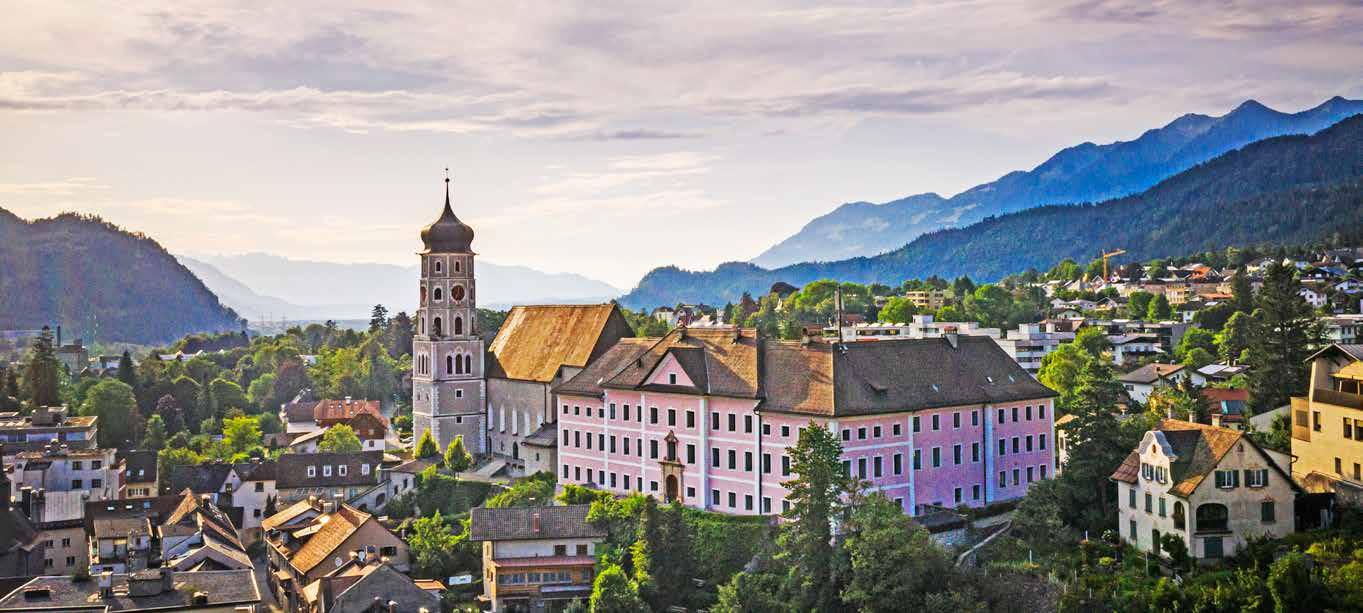
straight away? Of course not. So you set off to walk around the lake to soak in more of this panorama. And all the hikers you encounter coming the other way have all got that same rapturous look on their faces that you have. And they, too, keep stopping every 20 or 30 metres to take pictures.
It’s possible to meet the widest variety of different people in Brandnertal. That’s mainly because this valley has something for everyone. There’s a bike park and several mountain bike trails of varying levels of difficulty that lead through the beautiful landscape. There’s archery, too. And climbing, of course. Hikers will find more than 400 kilometres of hiking trails, the most charming of which take visitors to Loischkopf or Kesselfall and, when the weather is good, the high plateau of Tschengla with its Alpe Rona is so enchant ing that visitors often start asking themselves why they shouldn’t actually spend their entire holiday there.
Steep slopes do not bear down on Brandnertal unlike other valleys in the eastern Alps: it’s actually possible for visitors driving up from Bürs via Bürserberg and Brand to turn right or left into the gently rising
A day in pastel: Gayenhofen Castle in the Alpine town of Bludenz
landscape wherever and whenever they want. By the way, the Tierwelten-Weg (Animal World Trail) at Alpe Parpfienz is always a delight for kids. Interactive stations have been set up where they can play hide-andseek in marmot winter dens, join Bienen GmbH (Bees Ltd.) and learn more about birds of prey and owls.
For a valley that’s less than twenty kilometres long, it’s surprising how much there is to do in Brandnertal. And visitors shouldn’t forget to explore right to its end because there’s this lake high up that looks as if it’s been set like an aquamarine in between the mountains.

Klostertal Water at its most beautiful Klostertal is also home to a lake that plays a leading role there – Lake Formarinsee that is situated at 1793 metres above sea level with the Rote Wand in the Lechquellen Mountains. The lake is fed by melt water that flows from the peaks in spring – so it’s size varies. The body of water that frequently shimmers in an intense blue-green can be reached on foot from Klostertal, from Großes Walsertal and from Lech Zürs. Or on the hikers’ bus that travels through Zugertal directly to Lake Formarinsee.
Cycling and e-biking: heading off into the distance
Panorama cycling: short stop at Lake Seewaldsee in Großes Walsertal
Almost 300 kilometres of cycling and mountain-bike routes of all levels of difficulty invite visitors to discover the mountain world around Bludenz – and the most energy-saving way to do so is on e-bikes. The 155-kilometre-long five-valley mountain bike tour around Bludenz – best tackled on an e-bike – is one of the most charming. The five-day trip presents magnificent views of the Rätikon, the Verwall and Lechquellen Mountains and the Rhine Valley. www.alpenregion-vorarlberg.com/bike
Deep impressions: view of Braz in Klostertal
Generally, lots of things revolve around water here. The around 30-kilometre-long Klostertal (which branches off from Walgau near Bludenz and extends to the Arlberg and the Tyrolean border) is a narrow valley with steep slopes to the right and left that have waterfalls plunging down them from seemingly everywhere. Charming circular hiking trails lead, for example, to the Allmeinwasserfall and Fallbachwasserfall waterfalls. And then there’s the Alfenz that rushes through the centre of the valley – such landscapes are always called ‘wildly romantic’ in travelogues – as well as the municipalities of Klösterle, Dalaas and Innerbraz with their beautiful hotels, good restaurants and well-established traditions that are dotted along
»It must have once looked like this all over the world. «
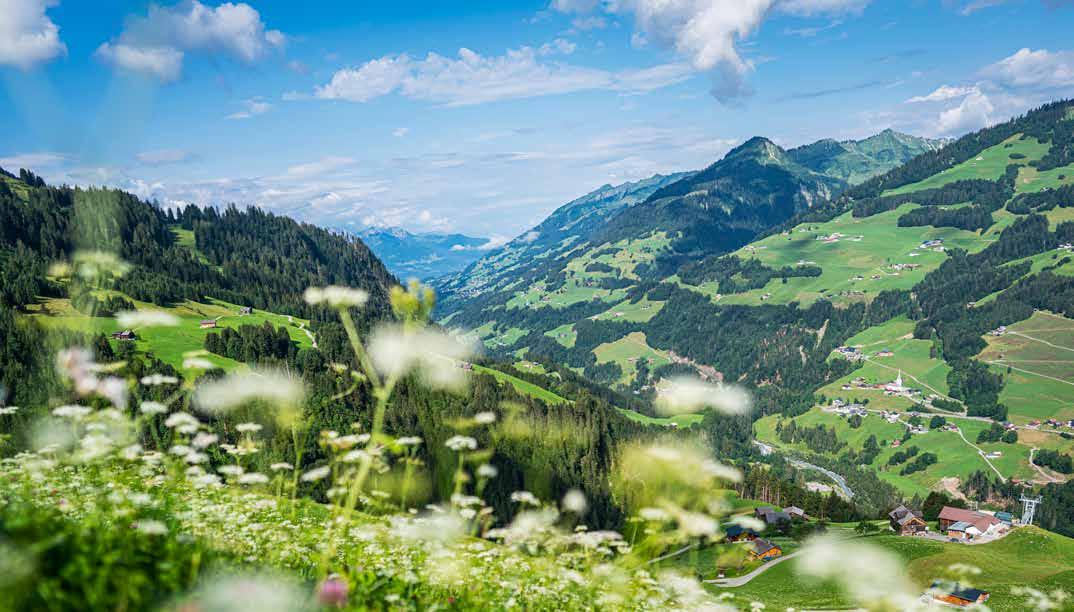
36 A feast for the eyes: the Lake Seewaldsee in Großes Walsertal
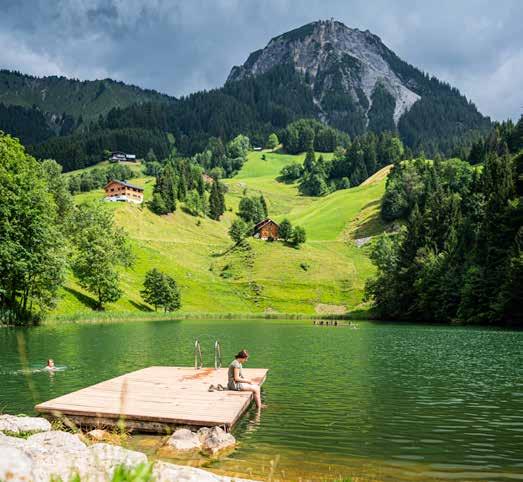
the landscape. Travellers have always been well looked after in Klostertal: the first hostels were built in the Middle Ages because the route between the Alpine ridges used to be a long and arduous one. Merchants and packers were able to find rooms and enjoy warm meals and one or two cups of wine at these stops. Klostertal has to this day remained a part of Vorarlberg where active visitors will feel right at home: you almost always have to climb high if you want to go hiking or mountain biking, perhaps to Lake Spullersee, to Muttjöchle or to the Wasserstuben-Alpe. Visitors not wishing to make the effort to go up that far may hike from Klösterle into the secluded Nenzigasttal up to the alp. Or even deeper into the Verwall Mountains.
People exploring the area between Bludenz and the Arlberg will at some point start asking themselves why the TV votes limit themselves to choosing just a single location as the one that’s most beautiful. Klostertal is home to many more that deserve the accolade.
Biosphere Park Großes Walsertal In harmony with nature And now just take a break somewhere, maybe just up there ahead, where there’s a nice view, stop, park the e-bike and … look. It’s really beautiful here, don’t you think? Some people even claim that Großes Walsertal was the model for all the other valleys in the Alps during the creation – although not all of them were as successful. Where else could you find 40 mountain peaks standing to attention? And where else would you feel that you’re cycling through one of those ‘Planet Earth’ documentaries that always seem to feature the most beautiful spots in the world?
The Biosphere Park Großes Walsertal is so wide in many places that it no longer looks like a valley but rather like an oversized model railway landscape. The towns and villages are marked by tapering church spires and the houses disappear behind infernos of colour in flower

Alpine meadow: 3D view from the mountain station in Sonntag-Stein in Großes Walsertal
Hiking fun: soundspace installation in Sonntag-Stein. Right: on the Alpe Nenzigast
boxes rushing by as cyclists pass through them. And then you’re already leaving Sonntag or Fontanella behind you and its back into the expansiveness, which, with all the mountains, is really not so wide … it’s rather a depth that seems to have everything, groves, meadows and pastures, lakes and rugged peaks further up. And everywhere the apparently harmonious coexistence of the rural cultural landscape and species-rich nature, fields and villages. It makes you think that everywhere else in the world must have once looked like this valley.

Perhaps that’s what the people who first settled in the valley and named it in the 14th century also thought. The Walser, a group of people who started out from the Wallis and established settlements all across the Alps, initially came from Switzerland. They were followed by others and they all lived in and off nature. Großes Walsertal has today been designated a UNESCO Biosphere Park. The organisation is of the view that it’s a habitat worth preserving. Großes Walsertal is practically a model for people to live in harmony with nature.
Visitors feel this every time they come into contact with the local residents, at every snack that the innkeeper on the Alpe Oberüberluth serves with a proud: “It comes from happy cows!” It can often be felt out on hikes and while chatting with the people who live here. Visitors can even feel it when they just climb off their e-bikes somewhere just to take it all in.
Bludenz and the three valleys Bludenz is a great place for visitors who want to dive into nature and culture in equal measures. A special plus: guests of the Alpine city, Klostertal and Brandnertal (Nüziders has not yet joined) will be eligible for a guest card that entitles them to free travel by train and bus across Vorarlberg. More information:
www.alpenregion-vorarlberg.com
Getting in touch with nature
Spending a week in the mountains, enjoying regional cuisine while out and about or watching the sun rise: there are very special ways of encountering Vorarlberg’s landscapes
1
Min Weag (My Path) – just keeps on going
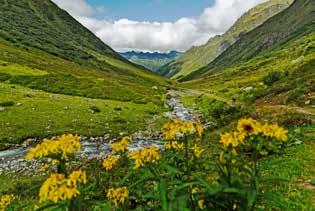
2
Give my regards to the sun Sunrises and sunsets develop their own magic – especially when the panorama is so extraordinary. It’s possible to experience these perfect moments in Vorarlberg on guided hikes to mountain peaks, such as the almost 2000-metre-high Mondspitze in the Brandnertal valley or the Hohe Fraßen in the Großes Walsertal Biosphere Park.Such trips are often followed by evening meals or breakfasts taken together on the mountain. The west-facing shore spots along Lake Constance, such as the steps on the Bregenz breakwater, are free of charge and also extremely popular. www.vorarlberg.travel/hiking
The circular ‘Min Weag’ hiking trail – ‘Min Weag’ is Vorarlbe rg dialect for ‘My Path’ – is 400 kilometres long and takes hikers across 15,000 altitude metres in 31 stages, from Lake Constance over the Silvretta and back to the starting point. The hike through hilly landscapes and alpine regions provides stimulating insights into a variety of habitats and results in many an enjoyable encounter. Directions, maps and additional information about the stages are also available from within the free Vorarlberg app. The new ‘Min Weag’ hiking guide published by the Löwenzahn Verlag is now available in bookshops. www.vorarlberg.travel/min-weag-circuit
Sightseeing by bus and train
It’s possible to easily explore Vorarlberg with inexpensive day tickets that allow travellers to hop on and off public transport. Set off independently across the region by train and the uniformly designed country buses that run at hourly intervals: from Lake Constance to Montafon, the Brandnertal valley, to Lech am Arlberg or from the towns in the Rhine Valley to the picturesque Bregenzerwald – or in the reverse direction. It is easy to stop off for culinary refreshments, strolls through villages or short circular hikes. www.vorarlberg.travel/ sightseeing-hop-on-hop-off
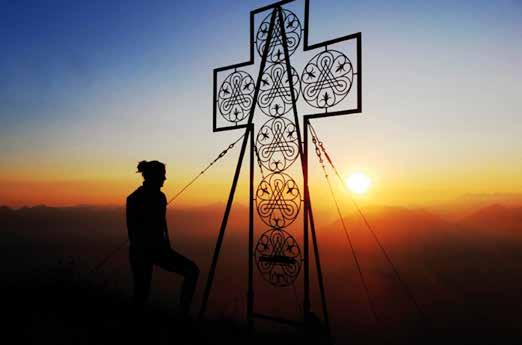
3
The most enjoyable dead end in the world ‘Kulinarische Talwanderung’ (‘Gourmet valley hike’) is the name of a tour through the Kleinwalsertal valley that is available for booking and for which five hours – but ideally the whole day – should be scheduled. The trip takes in three delightful inns in the valley. The first is Hotel Krone in Mittelberg – with Walser tapas and homemade mountain herb syrup. Followed by pork cheeks at Hotel Birkenhöhe. A vegetarian option is of course also available. And to round off the day, the Genuss- und Aktivhotel Sonnenburg will be serving Kaiserschmarrn made to grandma’s recipe. www.kleinwalsertal.com

Lake Constance
Hörbranz
Bregenz
1
GERMANY
SWITZERLAND
Dornbirn Hohenems Egg BREGENZERWALD
4
Feldkirch Rankweil Au-Schoppernau Damüls Mittelberg Warth Bludenz Brand
Schruns Stuben Lech Zürs V O R A R L B E R G MONTAFON KLEINWALSERTAL ARLBERG LIECHTENSTEIN BODENSEE –VORARLBERG
BRANDNERTAL – ALPENSTADT BLUDENZ – KLOSTERTAL – GROSSES WALSERTAL
AUSTRIA 2 3 4 4 4
SWITZERLAND
Gaschurn
Gargellen
Berggespür Vorarlberg Berggespür Vorarlberg – out and about with your personal mountain guide 4
Visitors may spend a week in the company of Vorarlberg mountain guides and acquaint themselves with various forms of movement in the mountains and get to know the natural alpine world: the new and out-of-the-ordinary ‘Berggespür Vorarlberg’ (‘A Feeling for Vorarlberg’s Mountains’) programme has been created specifically to this end and allows small groups to enjoy tours through the mountains of Vorarlberg under the direction of two mountain guides. Active guests on these tours will be able to experience the Bregenzerwald, Arlberg, Klostertal und Montafon regions off the beaten track, along smugglers’ paths and at night, on fixed rope routes and across glaciers. They’ll cover up to 1,000 metres difference in altitude each day. The hikes will be interspersed with a trip on the e-bike once in a while.

Hikers wishing to experience that “mountain feeling” should be physically fit, surefooted and have the stamina for hikes that may last up to six hours per day. But there will also be enough time en route to regenerate and relax and enjoy nature thanks to regular breaks. Participants will be accommodated overnight in comfortable hotels along the way – including cosy stops in the evenings.
www.vorarlberg.travel/berggespuer-mountain-feeling
Art is the path
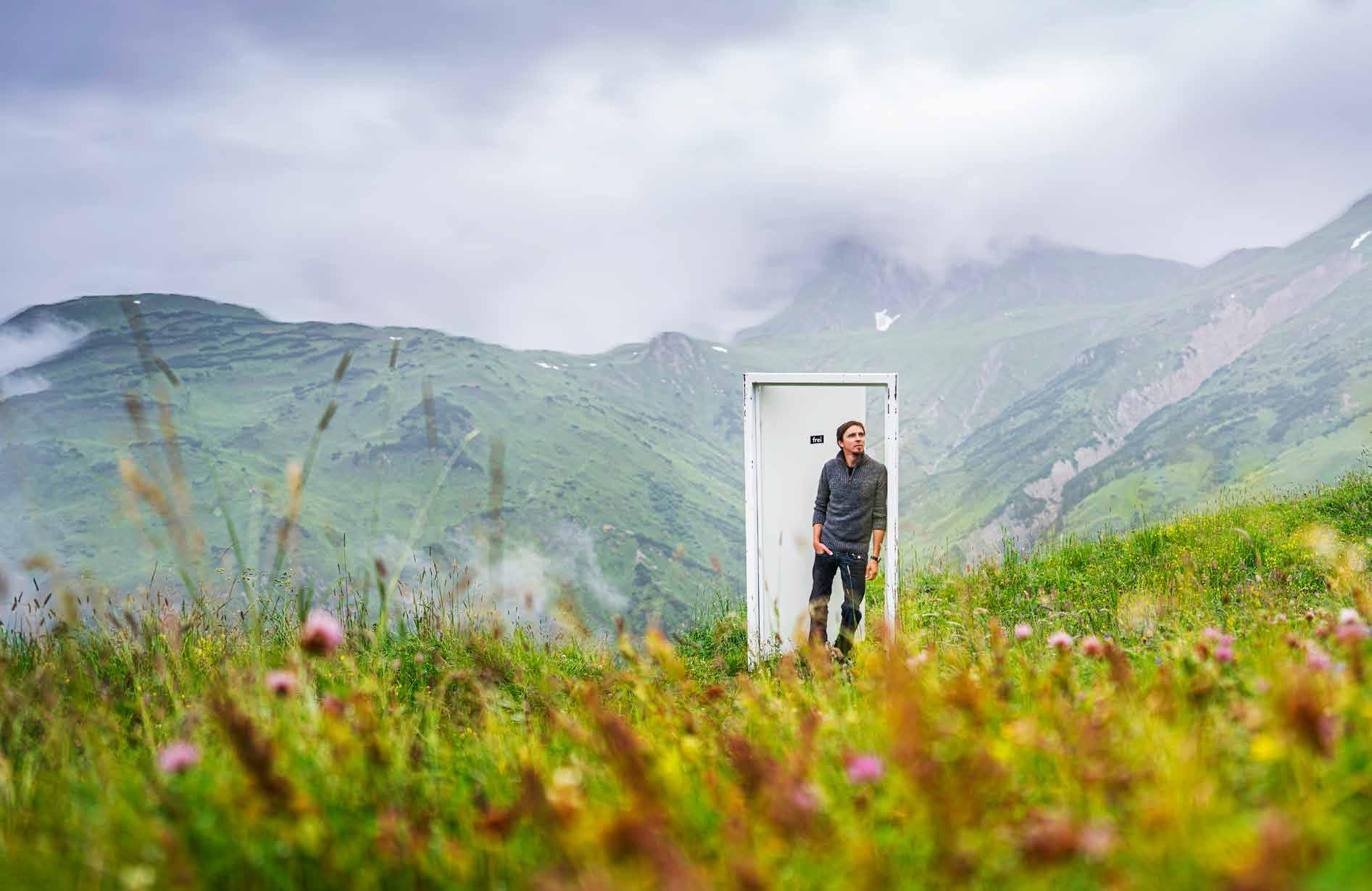
Daniel Nikolaus Kocher has created a series of different sculptures and art objects for the hiking trail that is the Green Ring am Arlberg. These often temporary installations make the mind and imagination soar. And then there are also the modern fable worlds that cast their spells over hikers of all ages. A tour…
TEXT: STEFAN NINK

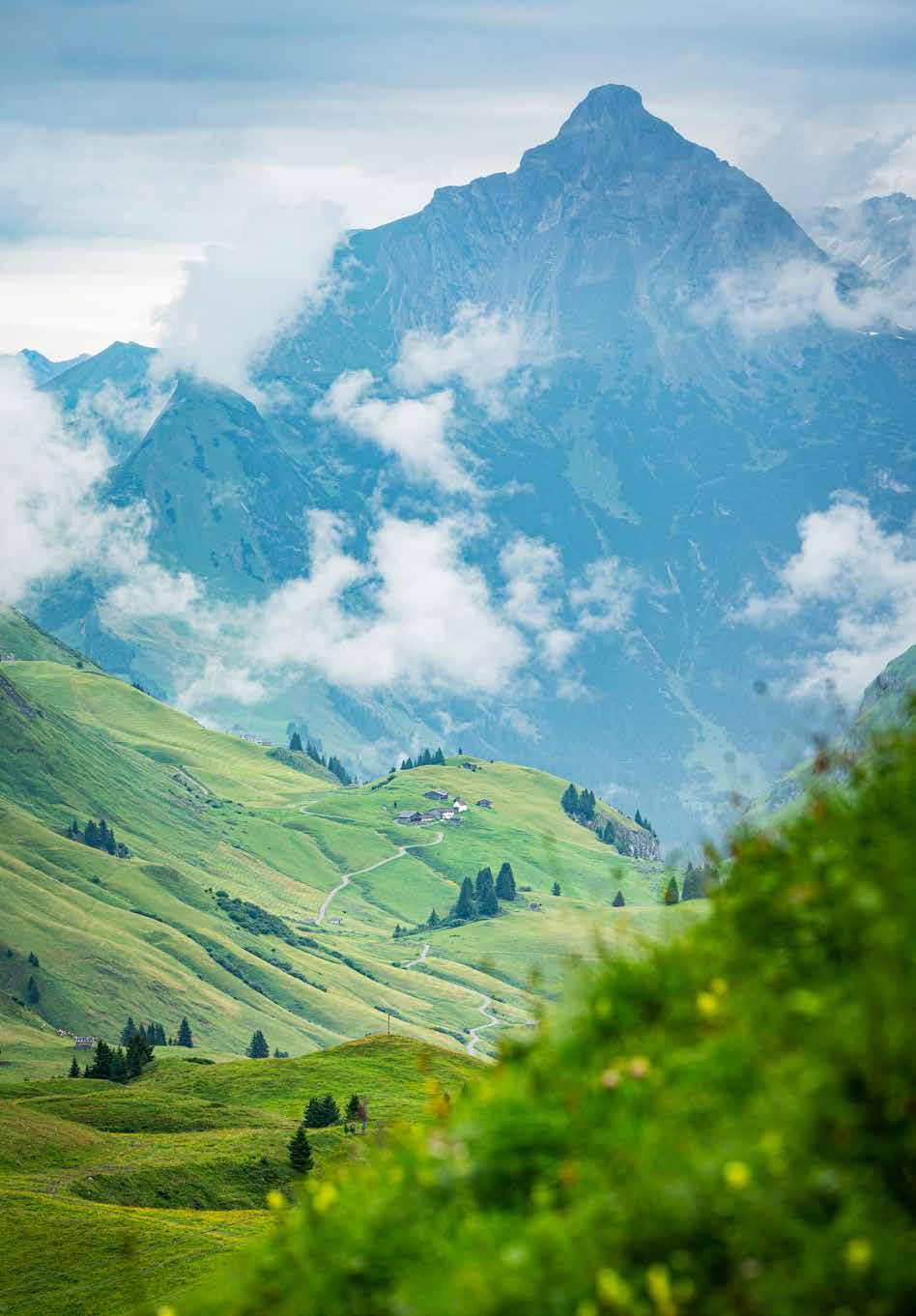
Daniel Nikolaus Kocher
Last summer, as the season was ending, he hid behind a rock again, up at Zürsersee lake. Daniel Nikolaus Kocher was checking one of the doors when he heard the voices of approaching hikers. So he decided to hide and do what he always does when he’s on the Green Ring, which is to watch how people interact with the art up there. Well, it is rather unusual to walk around a corner in a meadow high above Lech and suddenly find yourself standing in front of a closed door. “You always see very different reactions,” says Kocher. But something like the other day at the Zürsersee lake? “Two of the hikers actually walked around the door as if it wasn’t there at all. They just kept going without interrupting their pace.” Behind his rock, the curator of the Door Project and the Green Ring’s Artistic Director was dumbfounded, he’d never seen anything like it before. And the others in the group? They responded to the door, he says. Which is what actually everyone normally does. They walked through it back and forth several times before taking selfies. “They interacted with the art, each in their own way. Which is precisely why we installed it up there at the Green Ring.”

A wall bearing the names of the inhabitants of Lech
‘Up there’: the Green Ring is a hiking trail that takes hikers around Lech am Arlberg at an altitude of 2,000 metres and has, for a number of years now, made it possible for them to not only enjoy the spectacular 180-degree panoramic views but also encounters with art. Daniela Egger, who is a writer from Bregenz, has invented a complete world of legends for the trail and Daniel Nikolaus Kocher has created the appropriate sculptures for it. A hut library (where everyone can find something appropriate to read while taking a break from hiking) and an installation at the Europäische Wasserscheide (the watershed where visitors are able to see how the water on one side flows towards the North Sea and towards the Black Sea on the other) were gradually added, among other things, over time. The sixty-metre-long ‘Lecher Mauer’, which is to be found
The doors and what’s behind them
Each door has its own story – and now even new locations. Three examples:
This door has been dedicated to the subject of being free. What do I need to be free? How much – or how little? That’s something for hikers to ponder after encountering the door by designer Andreas Knoop. It now resides with its sponsors Natascha and Joschi Walsch at Hotel Gasthof Rote Wand in Lech, where it’s possible for visitors to view and interact with it at any time.
The door by author Daniela Egger is rusty but yet not old. It revolves around a world that’s somewhere between reality and fantasy, that’s home to concealed beings and a samurai. The rust stands for the decay that is inevitable in nature. The door has now relocated from its previous location on the Kriegerhorn to the B u rg Hotel that is run by the Lucian family in Lech.
The door with mountain and QR code was realised by graphic designer Martina Strolz. The code was created during a project by young people living in Lech who used it as an opportunity to see what their futures might hold. The door is sponsored by the Raiffeisenbank Lech, which installed it at the Libellensee lake in Oberlech in summer – a creative space for children and young people.
right behind the mountain station of the Petersbodenbahn cable car, lists the names of all the townspeople on its stones, in a sense as a permanent and everlasting contrast to the storage of digital data that has taken hold down in the valley.
A letterbox with postcards that visitors can write and post on the spot stands just a few metres further on. Lech Zürs Tourismus GmbH handles the postage at the end of the hiking season: ‘Emptied once a year at 4.00 p.m.’
There’s a separate Green Riddle. Ring for children
But the doors designed by nine artists from five different countries probably produced the most beautiful ‘What’s that?’ moments over the last three summers. Lines from a story were written on one of them, another had a small sign with the word ‘free’ on it, which
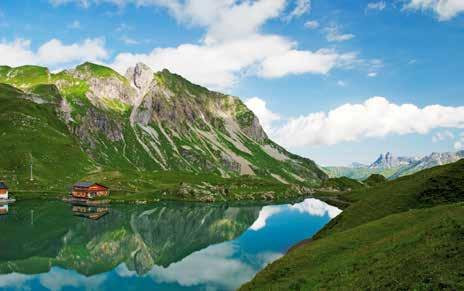
Stage 2 also leads to lake Zürsersee (below). Right: Riddle Ring from Lech to RudAlpe
immediately triggered associations under the endless arcing skies above Lech. And another one looked – well, just like a normal white door. The spyhole through which people could peep only became visible to them as they approached. And it suddenly made the seemingly endless world of peaks and ridges appear very small and manageable. The doors were brought down from the mountain last autumn. They have found new homes with their sponsors where they can now be admired (see box, page 43).
It’s possible to hike around the Green Ring in separate stages over the course of three days and ride back to the valley at the end of each stage. But it’s still possible for visitors to encounter art even if they’ve only an hour to spare. They simply have to walk just a few hundred metres into the Vorarlberg mountains along with their children for whom the special Rätsel-Ring has been created. The art is supposed to be there for everyone, not just for those who manage 25 mountain kilometres a day. And it is intended that there will always be different encounters with art. Daniel continues to install small temporary works along the trail, which requires no or hardly any intervention at all into nature and which then disappear again after a few years. He wants guests to be able to regularly experience something new, he says. Those who’ve already hiked around the Green Ring should be able to discover different art next time.
»The doors make you think – about rooms that you enter or leave. «
And, in the best case, a new mountain world. “Taking works of art out of their context and introducing them into new ones always affects the surroundings,” says Daniel. “They then also change the way people perceive nature.” The art on the Green Ring creates highlights and, because it often seems to hikers that the works appear out of nowhere, it changes their view of some of the most beautiful summit-and-valley panoramas in Austria. Daniel Nikolaus Kocher calls it making outdoor spaces tangible.
Seeing the mountains differently through art: Riese Taurin (Taurin, the Giant) on the Green Ring
You could also say that the works of art on the Green Ring succeed in making people look differently at the landscape above Lech. You suddenly see things that you wouldn’t have noticed otherwise without encountering the art.
Most hikers on the Green Ring enjoy the food for thought that the art gives them and children like outdoor art anyway. Daniel Nikolaus Kocher and the Raiffeisenbank Lech organise an annual workshop for children in which the natural environment around the Libellensee lake is artistically decorated – with animals made from wood, leather, stone and paint.

With a little luck, it’s possible to get answers along the way – from the artist himself
So it’s not only possible to encounter art but also to participate in the activity. And sometimes it’s possible to meet the artist while hiking. And ask questions as well as get answers. When Daniel isn’t hiding behind a rock.
The artist Daniel Nikolaus Kocher (born 1981) has been the Green Ring’s Artistic Director since 2009. He specialises in art projects in nature and in unusual places.
More information:
www.daniko.info; www.lechzuers.com/the-green-ring
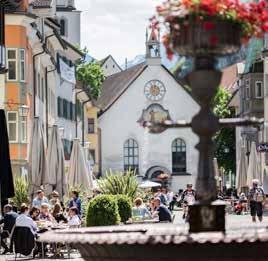
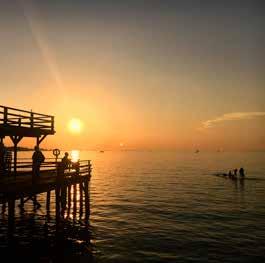
Visit us on our social media channels and post your holiday impressions from Vorarlberg
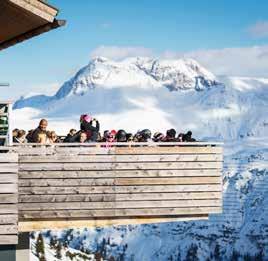
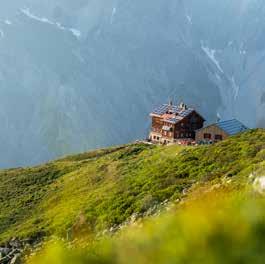
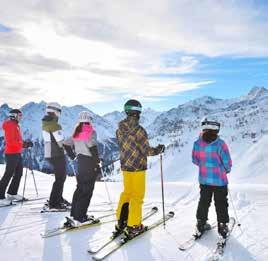
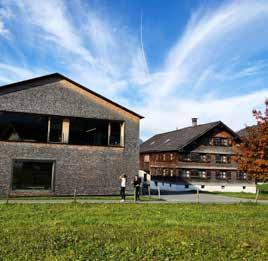
#myvorarlberg #visitvorarlberg
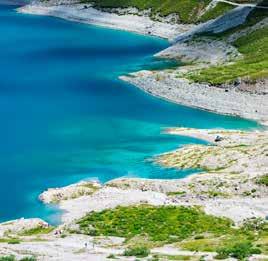
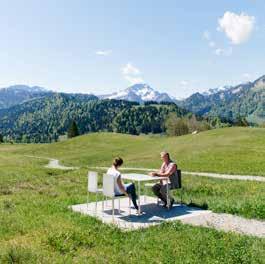



Our Social Guide: vorarlberg.social vorarlberg.social is where the social media community reveals what there is to discover in Vorarlberg. Let yourself be inspired, informed and – with a little luck – become part of the Social Guide Vorarlberg with your posts yourself. You also find Vorarlberg on these channels:

facebook.com/ urlaubsland.vorarlberg
instagram.com/ visitvorarlberg
youtube.com/ myVorarlberg
vimeo.com/ visitvorarlberg

pinterest.com/ visitvorarlberg
twitter.com/ visitvorarlberg



Culture to go in Kleinwalsertal valley
It’s possible while hiking to discover stories that have been told for around 700 years and walk in the footsteps of Walser families in and around Mittelberg. A trip through time – with refreshingly modern stopovers

TEXT: KORNELIA DIETRICH PHOTOS: DIETMAR DENGER



